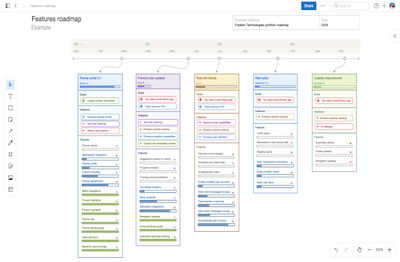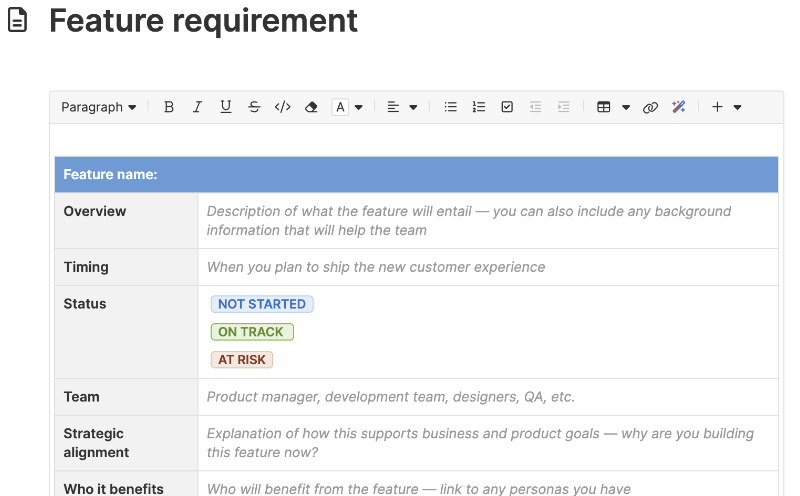
About the Kano model template
Prioritizing product work is essential to delivering value. You need an objective way to determine which features support your strategy and meet customer needs. The Kano model is a prioritization framework that can help you understand the functionality customers expect and pinpoint what will delight them. Try this Kano model template to think deeply about which efforts you should prioritize to elicit customer happiness.
Included in the Kano model template
This Kano model template includes built-in capabilities such as:
A menu of classic whiteboard features (including sticky notes, grids, and emojis)
Quick access to best practices and a pre-filled Kano model example for guidance
Inline comments to gather feedback, questions, and ideas from teammates
A voting tool to help everyone reach a consensus
Shapes you can convert directly into Aha! work records when plans are set
Presentation frames to easily share your work
Overview of the Kano model template
Use the Kano model template to help you prioritize product features. Add a sticky note to represent each feature, then arrange them on your board using these Kano classifications:
Must-haves: Essential functionality customers expect as a minimum requirement (for example, a bed in a hotel room)
Performance: Features that directly correlate with customer satisfaction (for example, a noticeably comfortable mattress on the bed in a hotel room
Delighters: Unexpected, but highly appreciated additions that can differentiate your product in the market (for example, a complimentary chocolate on your pillow)
These classifications help you distinguish between what customers want (performance and delighter features) and what customers need (must-have features) — showcasing the most valuable work for the team to prioritize.
How to use the kano model template
Prioritize product features based on how they will inspire customer love.
Explore options: Compare the potential value of features based on their likelihood of satisfying (or disappointing) customers. Add sticky notes or shapes to represent new functionality, or import existing work items as cards directly from Aha! Roadmaps.
Capture customer sentiment: Use emojis to convey how customers feel about features. Indicate whether each one generates excitement, positively impacts performance, or is a must-have requirement that customers expect.
Assess need vs. satisfaction: Place features on the Kano model. Delighter and must-have features typically have a stronger impact on customer satisfaction (positive or negative), whereas performance features follow a more linear path. Items near the grid's center fit into the indifference zone.
Align on priorities: Invite colleagues to weigh in. Move features around as you discuss how best to meet customer needs. Run a voting session to determine which ones to move forward. Then, add them to your roadmap.
FAQs about the Kano model template
Why is a Kano model important?
The Kano model encourages product managers to think differently about product prioritization. Instead of ranking features by urgency or effort, this model encourages you to consider whether they meet basic user expectations, provide performance improvements, or create moments of delight. Use this framework to discover opportunities to differentiate your product and determine where to best focus the team's energy.
What are some Kano model best practices?
Before bringing items onto your whiteboard, clearly define the features you want to prioritize. Invite the broader product team to participate in prioritization discussions. Update your model to keep it accurate as customer preferences evolve. And remember to source new insights and feedback from surveys, interviews, and ideas portal entries.
Who is the Kano model template for?
Typically, product managers and UX designers use the Kano model to prioritize features. It is especially helpful for smaller teams with limited resources because it focuses your efforts on the most impactful work. Try this template when you are bringing a new product to market or moving items from the backlog to your roadmap.
Is this template free to use?
Yes. To use this Kano model template, sign up for a free 30-day trial of Aha! Whiteboards. (You can also try this template in Aha! Roadmaps if you need a complete product management solution.) Easily customize the template to suit your needs, then share it with as many people as you want (for free) to streamline collaboration.





